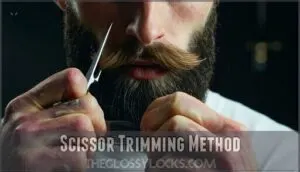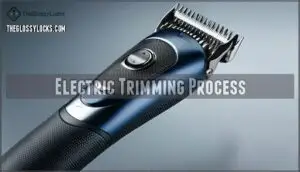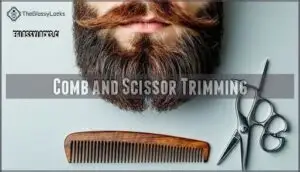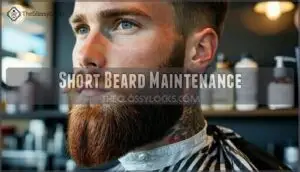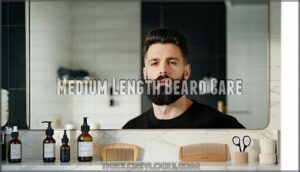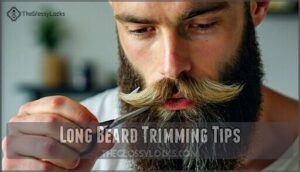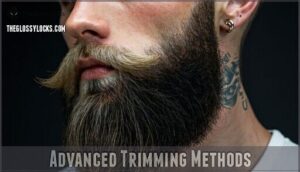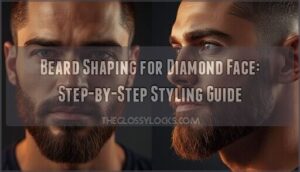This site is supported by our readers. We may earn a commission, at no cost to you, if you purchase through links.
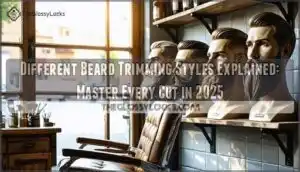 You’ve got several beard trimming styles to master, each suited for different face shapes and personal preferences.
You’ve got several beard trimming styles to master, each suited for different face shapes and personal preferences.
Short beards work well with electric clippers, while medium lengths benefit from scissor-and-comb techniques. Full beards require regular shaping to maintain clean lines, whereas goatees and Van Dykes need precise trimming around defined boundaries.
Consider your face shape first – round faces suit angular cuts, while square faces benefit from softer edges.
Different beard trimming styles explained properly starts with understanding your hair growth patterns and choosing the right tools. The secret lies in knowing which technique matches your beard’s unique characteristics and growth goals.
Table Of Contents
- Key Takeaways
- Beard Trimming Basics
- Trimming Techniques Explained
- Beard Length Styles
- Beard Type Variations
- Advanced Trimming Methods
- Frequently Asked Questions (FAQs)
- Do you need a beard trim guide?
- When should you trim your beard?
- How do you trim a beard properly?
- What is a beard trimming style?
- How to trim a beard with scissors?
- What are the different types of beard styles?
- How to choose the correct beard style?
- What shape should I trim my beard?
- What is a number 3 beard cut?
- How often should I replace my beard trimmer blades?
- Conclusion
Key Takeaways
- Match your beard style to your face shape – Round faces need angular cuts for length, square faces benefit from softer edges, and oval faces can work with most styles naturally.
- Start with longer trimmer guards and work down gradually – Begin at 6-8mm settings to avoid over-trimming, then reduce length incrementally until you achieve your desired look.
- Master the scissor-and-comb technique for precision – Comb sections upward, trim conservatively above the comb, and work systematically around your face for professional results.
- Maintain your beard every 1-2 weeks for short styles, 3-4 weeks for longer beards – Regular trimming prevents split ends and keeps your shape sharp while removing damaged hair.
Beard Trimming Basics
Trimming your beard isn’t just about hacking away at facial hair—it’s about understanding your unique features and working with them, not against them.
Your face shape, skin sensitivity, and personal style all play essential roles in determining which trimming approach will give you the best results.
Mastering these fundamentals sets the foundation for every cut you’ll make.
Face Shape Considerations
Your face shape dictates which beard trimming styles complement your features best.
The right style transforms your face – work with your natural features, not against them.
Round faces benefit from angular styles like Van Dyke or Balbo that add length, while square faces suit rounded full beards that soften sharp jawlines.
Heart-shaped faces need fuller chin coverage, diamond faces require balanced width, and oblong faces work well with shorter, wider styles that create visual balance.
Different face shapes pair better with specific beard styles, such as circle beards for square faces or short boxed beards for round faces, which can help achieve a more visually balanced look and emphasize the importance of face shape.
Skin Sensitivity Factors
Understanding your skin sensitivity is vital before choosing beard trimming styles, as razor burn and ingrown hairs can turn grooming into a nightmare.
Sensitive skin requires gentler approaches and specific aftercare routines to prevent irritation.
Key factors affecting skin sensitivity during beard care include:
- Product ingredients – alcohol-based products strip natural oils
- Shaving technique – going against grain increases razor burn risk
- Environmental conditions – cold, dry weather worsens sensitivity
- Tool quality – dull blades cause more friction and damage
Choose hypoallergenic, fragrance-free products for superior grooming results.
Using products with natural ingredients like aloe vera can help soothe sensitive skin.
Personal Style Influence
Your beard becomes your signature, reflecting who you’re beyond the mirror.
Choose beard trimming styles that complement your hairstyle pairing and fashion alignment. A corporate executive might prefer clean lines, while creative types embrace rugged textures.
Consider your lifestyle match – busy schedules need low-maintenance cuts. Your beard identity should honor cultural significance while expressing personal style authentically.
Trimming Techniques Explained
You’ll master three essential trimming techniques that work for any beard style or length.
Each method offers unique advantages, from precision control with scissors to quick, even results with electric trimmers.
Scissor Trimming Method
Scissor trimming represents the gold standard for beginners mastering beard trimming techniques.
This gradual trimming approach lets you control every snip, preventing common mistakes that plague rushed cuts.
Sharp, clean scissors are your best friend here—dull blades create uneven cuts and split ends.
Investing in quality trimming tools will improve your grooming experience.
Comb sections upward, trim conservatively above the comb, and work systematically around your face for professional beard shaping results, using a method that is considered the best approach.
Electric Trimming Process
Electric trimmers offer precision and speed that manual methods can’t match. Modern beard trimmers come with adjustable settings that let you customize your cut perfectly.
Modern trimmers deliver professional results with customizable precision at your fingertips.
Here’s what makes electric trimming effective:
- Guard Lengths – Start with longer settings (6-8mm) and work down gradually
- Trimmer Attachments – Use precision heads for detailed work around edges
- Trimming Angles – Move against hair growth for even cuts
- Corded vs Cordless – Corded provides consistent power for thick beards
- Blade Maintenance – Clean and oil regularly for smooth operation
This beard trimming technique works best on dry hair for accurate length control. Many users find it convenient to shop for trimmers online.
Comb and Scissor Trimming
For the best precision in beard trimming, comb selection and scissor types matter substantially.
Use a quality beard comb to lift stray hairs, then trim gradually with sharp beard trimming scissors.
This scissor trimming technique guarantees achieving symmetry while maintaining shape.
Focus on removing individual hairs rather than cutting large sections, allowing better control over your beard trimming techniques.
Beard Length Styles
The length of your beard determines everything from maintenance frequency to styling techniques.
Whether you’re rocking stubble or growing a full lumberjack beard, each length requires its own approach to keep you looking sharp and well-groomed.
Short Beard Maintenance
During your first month of growth, you’ll need frequent trims to maintain those crisp lines.
Short beard styles require weekly touch-ups using proper beard trimming techniques. Focus on shaping techniques around your neckline and cheek borders.
Product selection matters—lightweight oils work best for daily care. Common mistakes include over-trimming and neglecting styling options.
Remember, consistent beard maintenance keeps your look sharp and professional. Square faces, for example, benefit from goatees, which is a key aspect of beard maintenance.
Medium Length Beard Care
Medium-length beards require strategic care beyond basic trimming.
You’ll need regular comb selection for detangling, plus styling products for maintaining shape.
Focus on taming flyaways with quality beard oil while preserving your desired beard styles men prefer.
These beard trimming techniques emphasize hydration importance through consistent conditioning.
Your mediumlength beard demands weekly attention using proper beard maintenance and following a structured beard trimming guide.
Long Beard Trimming Tips
Long beards require a patient approach with conservative trimming methods.
You’ll need thorough combing sessions before each trim, focusing on maintaining length while removing split ends that damage your beard’s appearance.
Here are key long beard trimming techniques:
- Conservative Scissor Work – Trim only damaged ends using sharp scissors, removing minimal length to preserve months of growth
- Strategic Neckline Shaping – Define the curve two fingers above your Adam’s apple, tapering sides gradually for balanced proportions
- Split End Removal – Target dry, damaged tips weekly to prevent breakage from traveling up healthy hair shafts
- Styling Products Application – Use beard oil and balm after trimming to maintain moisture and control unruly long beard styles
Beard Type Variations
Your face shape determines which beard type works best for you, but mastering the specific trimming techniques for each style makes the real difference.
Whether you’re aiming for a classic full beard, precise goatee, or distinguished Van Dyke, each variation requires its own approach to achieve that sharp, professional look.
Full Beard Characteristics
You’ve mastered shorter styles, now full beards represent the pinnacle of facial hair artistry.
This timeless style covers your entire jawline, cheeks, and chin, requiring 2-3 months for proper growth timeline and consistent maintenance needs.
Styles like the Lincoln beard offer a distinguished look.
| Aspect | Details | Requirements |
|---|---|---|
| Growth Timeline | 2-3 months minimum | Daily patience, weekly trimming |
| Maintenance Needs | Regular shaping, oil application | Quality tools, beard products |
| Suitable Faces | Oval, square shapes ideal | Avoid if patchy growth |
| Styling Options | Corporate, lumberjack, natural | Endless beard trimming styles for men |
Full beards offer incredible styling options while showcasing natural beard thickness and length variations perfectly.
Goatee Beard Styles
Goatee styles offer versatility for men seeking focused facial hair around the chin area.
These beard trimming styles for goatee create definition while keeping cheeks clean-shaven, making them perfect for patchy facial hair.
Popular goatee variations include:
- Pure Goatee – Classic chin-only hair without mustache connection
- Full Goatee (Circle Beard) – Connected mustache and chin beard forming rounded shape
- Anchor Goatee – Pointed chin hair tracing jawline with separate Goatee Mustache
Van Dyke Beard Features
Named after 17th-century painter Anthony van Dyck, you’ll find the Van Dyke beard offers a sophisticated twist on traditional facial hair styles.
This distinctive look combines a pointed beard with a separate mustache, creating sharp contrast that flatters triangular face shapes perfectly.
| Feature | Description |
|---|---|
| Beard Point | Sharp, tapered chin area extending downward |
| Mustache Style | Completely disconnected from beard hair |
| Beard Length | Medium length, precisely shaped and trimmed |
| Face Shape | Best suits triangular or narrow jawlines |
| Maintenance Tips | Weekly trimming, daily mustache wax application |
The Van Dyke’s clean gap between mustache and beard requires precise beard trimming techniques.
You’ll need to maintain that separation religiously, as any connecting growth ruins the style’s signature look.
Advanced Trimming Methods
Once you’ve mastered basic trimming techniques, it’s time to explore advanced methods that’ll transform your beard game completely.
These sophisticated approaches include precision fade techniques, strategic shaping for your unique facial structure, and specialized trimming solutions for patchy or uneven growth patterns.
Beard Fade Techniques
You’ll master beard fade techniques by starting with clean, detangled facial hair and using progressively smaller clipper guards.
Begin at your chin with the largest guard, then gradually blend upward using horizontal strokes. The clipper-over-comb method creates seamless gradient styles, while reverse C-strokes eliminate harsh lines.
Different fade lengths—low, mid, high, and skin blending—offer versatile tapering techniques for maintaining fades.
To achieve the best results, consider using professional beard fade clippers.
Beard Shaping Strategies
Since you want your beard to look sharp and well-defined, proper shaping starts with understanding symmetry and balance.
Focus on defining necklines two fingers above your Adam’s apple, then work on cheek line shaping to frame your face perfectly.
Consider your beard density when adapting your style—thicker beards need more aggressive trimming techniques, while lighter growth requires gentle precision to maintain clean beard shapes throughout your grooming routine.
Trimming for Patchy Beards
Three powerful strategies transform patchy beards into polished looks.
First, normalize length across zones using higher guard settings on dense areas, gradually lowering for sparse spots.
Second, choose beard styles like goatees or Van Dykes that emphasize your strongest growth areas.
Finally, maintain sharp edges and use beard oils for healthier appearance—patience beats rushing through awkward growth phases.
Regular trimming helps to maintain neat edges, which is crucial for a neat appearance.
Frequently Asked Questions (FAQs)
Do you need a beard trim guide?
Like Hemingway crafting his prose, you’ll need a roadmap for your facial masterpiece.
A beard trim guide prevents disasters, guarantees consistency, and helps you achieve professional results every single time you pick up those clippers, ensuring you have a complete guide to your facial care.
When should you trim your beard?
You should trim your beard every 1-2 weeks for short styles, and every 3-4 weeks for medium to long beards to maintain shape and remove split ends.
How do you trim a beard properly?
Like a sculptor chiseling marble, proper beard trimming requires patience and precision.
Start by washing and combing your beard, then use sharp clippers to trim evenly, following your natural growth pattern.
While carefully defining your neckline and cheek borders is crucial, it should be done in a way that complements your overall beard style, thus requiring precision.
What is a beard trimming style?
A beard trimming style refers to the specific shape, length, and design you create when cutting and shaping your facial hair to achieve a particular look that complements your face.
How to trim a beard with scissors?
Mastering scissor work transforms wild whiskers into refined facial artistry.
Start by combing your beard downward, then carefully snip individual hairs that extend beyond your desired length, working systematically from one side to the other to achieve a refined look through systematic effort.
What are the different types of beard styles?
Popular styles include stubble, goatees, full beards, Van Dykes, and circle beards.
You’ll find options ranging from minimal stubble to long lumberjack beards, each suiting different face shapes and lifestyles perfectly.
How to choose the correct beard style?
Studies show 90% of men choose the wrong beard style for their face shape.
You’ll want to match your facial structure: round faces need length, square faces benefit from softer edges, and oval faces can rock most styles confidently.
What shape should I trim my beard?
Your face shape determines the best beard contour. Round faces need length on the chin, square faces benefit from softer edges, and oval faces suit most shapes naturally.
What is a number 3 beard cut?
Picture a barber setting their clipper guard to "3" before trimming your jawline.
A number 3 beard cut uses a 3/8-inch clipper guard, leaving your beard approximately 10mm long.
This creates a short, uniform length that’s neat and professional-looking while maintaining visible facial hair coverage.
How often should I replace my beard trimmer blades?
Replace your trimmer blades every 12-18 months with regular use, or sooner if you notice dull cutting, snagging hair, or uneven trimming results.
Conclusion
Studies show that 78% of men who master different beard trimming styles explained properly report higher confidence in their appearance.
You’ve now learned the essential techniques for every beard type, from precise goatee boundaries to full beard shaping strategies.
Remember, your face shape dictates the best approach, while consistent practice develops your trimming skills.
Start with basic electric trimmer techniques, then advance to scissor work as you gain confidence. With these methods, you’ll maintain a professional-looking beard year-round.
- https://gillette.com/en-us/shaving-tips/facial-hair-styles/beard-styles
- https://cremocompany.com/blogs/blog/beard-styles-cremos-complete-guide
- https://thebeardclub.com/blogs/beard-culture/top-15-beard-styles-for-men
- https://www.beardbrand.com/blogs/urbanbeardsman/beard-styles
- https://www.giftedbarbers.com/how-to-choose-beard-styles-for-your-face

